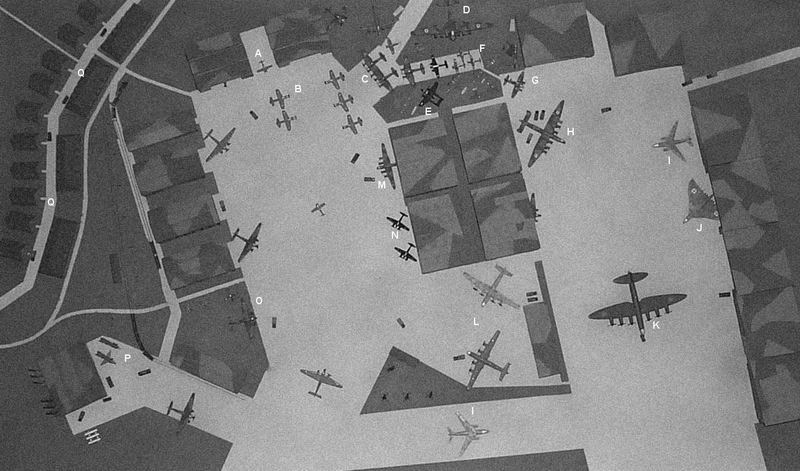


Aerial intelligence photo of E-Stelle 700 taken in April 1947
|
A |
Focke Wulf FW-190 of the Rote Pfeile |
G |
Me-109 / Ju-88 Mistel |
M |
Hitler's personal FW-200 |
|
| |||||
Brief history of E-Stelle 700During 1944 the RLM realized that in order to maintain Germany's technological lead more coordination of the various research activities was necessary. The decision was made to centralize all research facilities in one location. For this a new technological center was formed where all research and development was to be coordinated. This decision lead to of formation of E-Stelle 700. A new location near Nürnberg was developed and all research and testing locations were moved to the new location. This meant that the Rechlin facility was abandoned in 1945. Because of the special location of the facilities at Travemunde (Seaplanes & Flying boats) and Peenemunde (Rockets) these were retained for testing purposes. All research was located at E-Stelle 700 however. E-Stell 700 saw the testing of all new Luftwaffe hardware including the Focke Wulf Ta-183, Heinkel He-343, Junkers Ju-418 and the Focke Wulf Ta-500. Later also the Junkers Ju-588, Arado Ar-555 and Messerschmitt Me-471 were test flown here.
| |||||
|
| |||||
|
E-Stelle 700 is divided into 6 sections or "Abteilungen". The physical lay-out of the facility mirrors this devision. The sections are: Abteilung 1: Fighters
| |||||
|
| |||||
|
In the spring of 1945 E-Stelle 700 also became the home of the official display team of the Luftwaffe. This unit was officially named JG 710 and was formed by pilots of JG 1, JG 3 and JG 51. Later also pilots from other units joined the team. Their first aircraft were ten Focke Wulf Fw-190A-5's, painted bright red. In 1946 the team switched to the Dornier Do-335 and adopted the name "Rote Pfeile". Also see my article on the team. The team operated three Junkers Ju-52 transports which were also painted red.
| |||||
|
| |||||
|
The site of E-stelle 700 became the storage area of the aircraft of the Air Museum in Berlin. Because many captured foreign aircraft were already on the site, E-Stelle 700 was the obvious place to preserve these aircraft. Captured aircraft included a number of Spitfires, P-51's, a P-36, a P-39, a P-61 and many more types. Also the personal aircraft of a number of high scoring aces were preserved for future display. Among them were the aircraft of Bär, Hartmann and Novotny. Several prototypes of German aircraft and noteworthy were also preserved here. These included a Messerschmitt Me-323, a Heinkel He-11Z and the prototype of the Me-262F, the single Me-109M-0 and the first Ta-183.
| |||||
|
| |||||
|
Frequent visitors at E-Stelle 700 were the Japanese. Long range aircraft carried scientists and documents to and from Japan in a program of technological exchange. The Luftwaffe used two Junkers Ju-390B-5 transports for this. These were powered by six Jumo 222 engines driving 5 bladed propellers. The Japanese used the enormous Nakajima G10N Fugaku aircraft.
| |||||
|
| |||||
|
Although all flight testing of the V-2 missiles was still conducted at Peenemunde, some limited experimentation was conducted at E-Stelle 700. This concerned both the "standard" V-2 as the winged version of the rocket which was to lead in 1952 to the first manned space flight in the A-12 rocket.
| |||||
|
The model This 1/700 diorama was made from materials and models from various sources. The buildings were partly made from Skywave kits and partly scratchbuilt. The aircraft came from Skywave, Pit Road and White Ensign Models. The vehicles are from HP-models and Pit Road. The figures come from Gold Medal. The He-111Z and the Mistel are conversions of Skywave and White Ensign aircraft.
|
|
|
Last updated: 14/03/2009